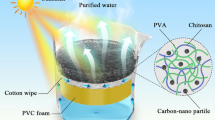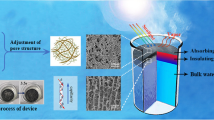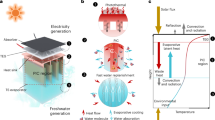Abstract
The integration of ionic power generation with solar-driven water evaporation presents a promising solution to the critical global problems of freshwater scarcity and clean energy deficiency. In this work, a scalable normal temperature chemical vapor deposition (CVD) method is applied for the first time to the fabrication of a cellulose@polypyrrole (CC@PPy) membrane with efficient ionic power generation performance. The excellent ionic power generation is intimately related to the water and thermal gradients across the membrane, which not only induces fast water evaporation but also synergistically promotes the transport of counterions in charged nanochannels, and the corresponding mechanism is attributed to the streaming potential resulting from the ionic electrokinetic effect and the ionic thermoelectric potential originating from the Soret effect. Under one sun illumination, the CC@PPy film can produce a sustained voltage output of ~ 0.7 V and a water evaporation rate up to 1.67 kg m−2 h−1 when an adequate water supply is available. This study provides new methods for the scalable fabrication of ionic power generation membranes and a design strategy for high-performance solar power generators.
Graphical Abstract






Similar content being viewed by others
Data Availability
The data that support the findings of this study are available from the corresponding author upon reasonable request.
References
Chen CJ, Kuang YD, Hu LB. Challenges and opportunities for solar evaporation. Joule. 2019;3:683.
Gao MM, Zhu LL, Peh CK, Ho GW. Solar absorber material and system designs for photothermal water vaporization towards clean water and energy production. Energy Environ Sci. 2019;12:841.
Xue GB, Xu Y, Ding TP, Li J, Yin J, Fei WW, Cao YZ, Yu J, Yuan LY, Gong L, Chen J, Deng SZ, Zhou J, Guo WL. Water-evaporation-induced electricity with nanostructured carbon materials. Nat Nanotechnol. 2017;12:317.
Gui JX, Li CC, Cao Y, Liu ZX, Shen YJ, Huang W, Tian XL. Hybrid solar evaporation system for water and electricity co-generation: Comprehensive utilization of solar and water energy. Nano Energy. 2023;107: 108155.
Zhang L, Xu ZY, Zhao L, Bhatia B, Zhong Y, Gong S, Wang EN. Passive, high-efficiency thermally-localized solar desalination. Energy Environ Sci. 2021;14:1771.
Yin J, Zhou JX, Fang SM, Guo WL. Hydrovoltaic energy on the way. Joule. 2020;4:1852.
Liu J, Gui JX, Zhou WT, Tian XL, Liu ZX, Wang JQ, Liu J, Yang L, Zhang P, Huang W, Tu JC, Cao Y. Self-regulating and asymmetric evaporator for efficient solar water-electricity generation. Nano Energy. 2021;86: 106112.
Zhou XB, Zhang WL, Zhang CL, Tan Y, Guo JC, Sun ZN, Deng X. Harvesting electricity from water evaporation through microchannels of natural wood. ACS Appl Mater Interfaces. 2020;12:11232.
van der Heyden FH, Bonthuis DJ, Stein D, Meyer C, Dekker C. Electrokinetic energy conversion efficiency in nanofluidic channels. Nano Lett. 2006;6:2232.
Wu YD, Qian YC, Niu B, Chen JJ, He XF, Yang LS, Kong XY, Zhao YF, Lin XB, Zhou T, Jiang L, Wen LP. Surface charge regulated asymmetric ion transport in nanoconfined space. Small. 2021;17:2101099.
Grahame DC. The electrical double layer and the theory of electrocapillarity. Chem Rev. 1947;41:441.
Gong BY, Yang HC, Wu SH, Tian YK, Guo XZ, Xu CX, Kuang WH, Yan JH, Cen KF, Bo Z, Ostrikov K. Multifunctional solar bamboo straw: multiscale 3D membrane for self-sustained solar-thermal water desalination and purification and thermoelectric waste heat recovery and storage. Carbon. 2021;171:359.
Fang SM, Chu WC, Tan J, Guo WL. The mechanism for solar irradiation enhanced evaporation and electricity generation. Nano Energy. 2022;101: 107605.
Zhou SY, Qiu Z, Strømme M, Xu C. Solar-driven ionic power generation via a film of nanocellulose @ conductive metal–organic framework. Energy Environ Sci. 2021;14:900.
He N, Wang HN, Li F, Jiang B, Tang DW, Li L. Ion engines in hydrogels boosting hydrovoltaic electricity generation. Energy Environ Sci. 2023.
Gan WT, Chen CJ, Giroux M, Zhong G, Goyal MM, Wang YL, ** WW, Song JW, Xu SM, He SM, Jiao ML, Wang C, Hu LB. Conductive wood for high-performance structural electromagnetic interference shielding. Chem Mater. 2020;32:5280.
Lu K, Liu C, Liu J, He Y, Tian X, Liu Z, Cao Y, Shen Y, Huang W, Zhang K. Hierarchical natural pollen cell-derived composite sorbents for efficient atmospheric water harvesting. ACS Appl Mater Interfaces. 2022;14:33032.
Wang X, Liu Q, Wu S, Xu B, Xu H. Multilayer polypyrrole nanosheets with self-organized surface structures for flexible and efficient solar-thermal energy conversion. Adv Mater. 2019;31: e1807716.
Wang XF, Lin FR, Wang X, Fang SM, Tan J, Chu WC, Rong R, Yin J, Zhang ZH, Liu YP, Guo WL. Hydrovoltaic technology: from mechanism to applications. Chem Soc Rev. 2022;51:4902.
Shao BB, Song ZH, Chen X, Wu YF, Li YJ, Song CC, Yang F, Song T, Wang YS, Lee S-T, Sun B. Bioinspired hierarchical nanofabric electrode for silicon hydrovoltaic device with record power output. ACS Nano. 2021;15:7472.
Sun ZY, Wen X, Wang LM, Yu JY, Qin XH. Capacitor-inspired high-performance and durable moist-electric generator. Energy Environ Sci. 2022;15:4584.
Zhu ZP, Wang DY, Tian Y, Jiang L. Ion/molecule transportation in nanopores and nanochannels: from critical principles to diverse functions. J Am Chem Soc. 2019;141:8658.
Wu YD, Zhou T, Wang Y, Qian YC, Chen WP, Zhu CC, Niu B, Kong XY, Zhao YF, Lin XB, Jiang L, Wen LP. The synergistic effect of space and surface charge on nanoconfined ion transport and nanofluidic energy harvesting. Nano Energy. 2022;92: 106709.
**ao K, Jiang L, Antonietti M. Ion transport in nanofluidic devices for energy harvesting. Joule. 2019;3:2364.
**e JH, Wang YF, Chen SG. Textile-based asymmetric hierarchical systems for constant hydrovoltaic electricity generation. Chem Eng J. 2022;431: 133236.
He XY, Gu JT, Hao YN, Zheng MR, Wang LM, Yu JY, Qin XH. Continuous manufacture of stretchable and integratable thermoelectric nanofiber yarn for human body energy harvesting and self-powered motion detection. Chem Eng J. 2022;450: 137937.
He XY, Shi J, Hao YN, He MT, Cai JX, Qin XH, Wang LM, Yu JY. Highly stretchable, durable, and breathable thermoelectric fabrics for human body energy harvesting and sensing. Carbon Energy. 2022;4:621.
Zhao D, Wang H, Khan ZU, Chen JC, Gabrielsson R, Jonsson MP, Berggren M, Crispin X. Ionic thermoelectric supercapacitors. Energy Environ Sci. 2016;9:1450.
Wang H, Ail U, Gabrielsson R, Berggren M, Crispin X. Ionic seebeck effect in conducting polymers. Adv Energy Mater. 2015;5:1500044.
Wang LM, He XY, Hao Y, Zheng MR, Wang RW, Yu JY, Qin XH. Rational design of stretchable and highly aligned organic/inorganic hybrid nanofiber films for multidirectional strain sensors and solar-driven thermoelectrics. Sci China Mater. 2023;66:707.
Li L, Feng S, Bai Y, Yang X, Liu M, Hao M, Wang S, Wu Y, Sun F, Liu Z, Zhang T. Enhancing hydrovoltaic power generation through heat conduction effects. Nat Commun. 2022;13:1043.
Liu YF, Cui MW, Ling W, Cheng LK, Lei H, Li WZ, Huang Y. Thermo-electrochemical cells for heat to electricity conversion: from mechanisms, materials, strategies to applications. Energy Environ Sci. 2022;15:3670.
Lin YW, Xu H, Shan XL, Di YS, Zhao AQ, Hu YJ, Gan ZX. Solar steam generation based on photothermal effect: from designs to applications, and beyond. J Mater Chem A. 2019;7:19203.
Shen D, Duley WW, Peng P, **ao M, Feng J, Liu L, Zou G, Zhou YN. Moisture-enabled electricity generation: from physics and materials to self-powered applications. Adv Mater. 2020;32: e2003722.
Huang W, Hu GY, Tian C, Wang XH, Tu JC, Cao Y, Zhang KX. Nature-inspired salt resistant polypyrrole-wood for highly efficient solar steam generation. Sustain Energy Fuels. 2019;3:3000.
Acknowledgements
This research was financially supported by the National Natural Science Foundation of China (Grant Nos. 52162012, 52262014, 22308074, 22368019), Key Research and Development Project of Hainan Province (Grant Nos. ZDYF2022SHFZ053), Science and Technology Innovation Talent Platform Fund for South China Sea New Star of Hainan Province (Grant No. NHXXRCXM202305), and Open Research Project of State Key Laboratory of Marine Resource Utilization in South China Sea (Grant No. MRUKF2023020).
Author information
Authors and Affiliations
Corresponding authors
Ethics declarations
Conflict of Interest
The authors declare no conflict of interest.
Additional information
Publisher's Note
Springer Nature remains neutral with regard to jurisdictional claims in published maps and institutional affiliations.
Supplementary Information
Below is the link to the electronic supplementary material.
Rights and permissions
Springer Nature or its licensor (e.g. a society or other partner) holds exclusive rights to this article under a publishing agreement with the author(s) or other rightsholder(s); author self-archiving of the accepted manuscript version of this article is solely governed by the terms of such publishing agreement and applicable law.
About this article
Cite this article
Liu, C., Gui, J., Li, D. et al. Ionic Power Generation on a Scalable Cellulose@polypyrrole Membrane: The Role of Water and Thermal Gradients. Adv. Fiber Mater. 6, 243–251 (2024). https://doi.org/10.1007/s42765-023-00353-w
Received:
Accepted:
Published:
Issue Date:
DOI: https://doi.org/10.1007/s42765-023-00353-w




